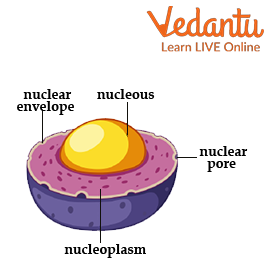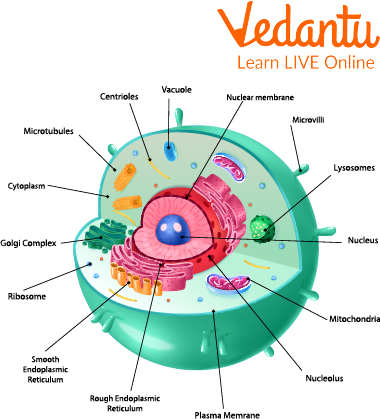




Why Is the Nucleus Vital to Living Cells?
Biology is that portion of science that assists in our comprehension of the functioning, growth, and engagements of the living world's varied species, also consisting of humans. The class of living has been enhanced as a result of developments in the field of biology, including those which are in medicine, agriculture, biotechnology, and many other fields. Cells are a component of biology. When you look at a photograph of a cell, one of the parts that stand out the most is the nucleus. The nucleus, located at the centre of the cell, is home to all of the chromosomes, which are responsible for encoding the genetic material. Let's explore the subject further and learn more about function and structure of nucleus and the definition of nucleus.
What is Nucleus?
Due to its role in the storage, retrieval, and duplication of genetic information, the nucleus is regarded as one of the most significant components of eukaryotic cells. It is an organelle with two membranes that are linked to it that contains chromatin, which is a kind of genetic material. It is made up of an ever-changing variety of nonmembranous subcompartments with various functional capacities. The specific characteristics of a cell nucleus rely on how differentiated the cell is within the organism, particularly in terms of the type and location of subnuclear compartments and the positioning of the chromosomes.

Cell Nucleus
Function of Nucleus
The following are some crucial nuclear functions:
It accelerates the growth of cells and reproduction and also does the holding of information related to genes.
The genetic make of a cell consists in the nucleus, which is discussed deeply as a membrane-bound structure.
Apart from serving as a storage for DNA, it also serves as the location of various significant cellular functions.
In the nucleus, a person’s DNA can be duplicated firstly. DNA imitation is the procedure that makes an exact duplicate of the DNA.
Cell division starts with making 2 perfect copies of the body or host, with every new cell getting a distinct set of information.
Structure of Nucleus
The structure of the nucleus is quite complex. Let’s now see in detail about it and where the nucleus is located.
It is traditionally the cell organelle that is observed most commonly and easily.
Membranes surround and fully enclose the nucleus.
The structure surrounding it is the nuclear envelope.
The cytoplasm and nucleus's inside contents are divided by the membrane. The chromosomes of the cell are also included within it.
The chromosomes, which have the DNA, provide the genetic data mandatory for the synthesis of various cell components as well as for the continuation of life.

Structure of a Nucleus
Facts About the Nucleus
Some facts of nucleus are as follows:
The first cell organelle identified was the nucleus. Antonie von Leeuwenhoek identified the nucleus in fish blood skin cells in the late 1600s.
The Latin term nucleus, which means "kernel," is where the word nucleus first appeared.
Eukaryotic cells contain the nucleus, a double membrane-bound organelle.
In the nucleus, you can find DNA and RNA.
An organism's hereditary features are controlled by the nucleus.
In the nucleolus of the nucleus, proteins and ribonucleic acid (RNA) are also stored.
Transcription, the first step in the production of proteins, starts in the nucleus.
An enormous organelle is a nucleus. In reality, a basic compound microscope will allow you to see the nucleus.
A nuclear membrane encircles the nucleus. This membrane has two layers and resembles the cell membrane very much.
The extra components of the nucleus are encased and shielded by the nuclear membrane.
Ribosomes can also be found outside the nuclear membrane.
Nuclear pores are holes found on the nuclear membrane's outer surface. The messenger RNA exits the nucleus through a nuclear pore after transcription.
Summary
In this article, we have learned about the function and structure of nucleus and the definition of nucleus. The DNA or genetic material of an organism is found in the nucleus. It can direct all of a cell's operations and contains the knowledge necessary to produce the proteins that a cell needs. Since it indirectly manages the functions of the cell, it serves as the brain or control centre of the organism.
Because it regulates all of the cell's activities, its feeding cycle, and its reproduction, the nucleus is situated closer to the cell's centre. It can quickly access every area of the cell thanks to its central location. We hope you enjoyed reading this article, in case of any other doubts, feel free to ask in the comments.
FAQs on Essential Facts About the Cell Nucleus
1. What is the nucleus and who discovered it?
The nucleus is a large, membrane-bound organelle found in most eukaryotic cells that contains the cell's genetic material. It acts as the cell's control centre. It was first described by the Scottish botanist Robert Brown in 1831 while he was studying orchids under a microscope.
2. What are the main functions of the nucleus in a cell?
The nucleus performs several critical functions to ensure the cell's survival and proper operation. Its primary roles include:
Storing Genetic Information: It houses the cell's hereditary material, or DNA.
Controlling Cell Growth and Division: It coordinates all metabolic activities and guides the process of cell division (mitosis).
Regulating Gene Expression: It controls which proteins are made by the cell by transcribing DNA into messenger RNA (mRNA).
Synthesising Ribosomes: The nucleolus, a structure within the nucleus, is the site of ribosome synthesis.
3. Why is the nucleus often called the 'brain' or 'control centre' of the cell?
The nucleus earns this title because it contains the DNA, which holds the complete set of instructions for everything the cell does. Just like a brain coordinates the functions of a body, the nucleus uses these genetic instructions to direct the synthesis of proteins, regulate metabolic processes, and manage cell growth and reproduction. All major cellular activities are ultimately governed by the information stored within and dispatched from the nucleus.
4. What are the key components of a nucleus?
A typical eukaryotic nucleus is composed of four main parts:
Nuclear Envelope: A double membrane that separates the nucleus from the cytoplasm. It contains nuclear pores that regulate the passage of molecules.
Nucleoplasm: A gel-like substance within the nuclear envelope that contains the other nuclear components.
Chromatin: A complex of DNA and proteins (histones) that condenses to form chromosomes during cell division.
Nucleolus: A dense structure inside the nucleus responsible for producing and assembling ribosomes.
5. What is the specific role of the nucleolus?
The nucleolus is primarily known as the 'ribosome factory' of the cell. Its main function is to synthesise ribosomal RNA (rRNA) and assemble it with proteins to form ribosomal subunits. These subunits are then exported to the cytoplasm to form complete ribosomes, which are essential for translating genetic information into proteins.
6. What happens to most eukaryotic cells if their nucleus is removed?
If the nucleus is removed from a eukaryotic cell, it cannot survive for long. Without the nucleus, the cell loses its genetic blueprint (DNA) and, therefore, its ability to produce new proteins and enzymes needed for repair and metabolic functions. It also loses the ability to reproduce. The cell may continue to function for a short period using its existing proteins, but it will eventually die as it cannot sustain itself.
7. Is the nucleus in a plant cell different from that in an animal cell?
Structurally and functionally, the nucleus in plant and animal cells is fundamentally the same. Both contain DNA, a nuclear envelope, a nucleolus, and nucleoplasm. The primary difference is its position. In a mature animal cell, the nucleus is typically located in the centre. In a mature plant cell, a large central vacuole often pushes the nucleus to the periphery, against the cell wall.
8. How is the vast amount of DNA organised to fit inside the tiny nucleus?
The cell uses a highly efficient packaging system. The long strands of DNA are wrapped around proteins called histones. This DNA-protein complex is known as chromatin. This chromatin is then further coiled and condensed into a compact structure. During cell division, this chromatin condenses even more to form visible, distinct structures called chromosomes, ensuring the genetic material can be accurately segregated into daughter cells.
9. Do all living cells have a nucleus?
No, not all living cells have a nucleus. Cells are broadly classified into two types based on this feature:
Prokaryotic cells (like bacteria) lack a true nucleus. Their genetic material floats freely in the cytoplasm in a region called the nucleoid.
Eukaryotic cells (in plants, animals, fungi) do have a nucleus. However, some specialised eukaryotic cells, such as mature red blood cells in mammals, lose their nucleus during development to maximise space for haemoglobin.





















